How To Install Tremolo Bridge
Congratulations on your purchase of the virtually versatile guitar tremolo bridge system in the world. Installed properly, this device will give you many years of cracking performance. So please read this entire installation guideline very carefully before beginning to install your new Kahler organization...
This guideline is but that ...a guideline. The principles in here utilise to every installation of whatever span in the earth. In a nutshell you will measure, locate east, westward, north and southward positioning of the trem, mark it out, route it out, spiral it down and set it upwards. Information technology's that simple. In that location are the tools needed for a do it yourself job. Proper installation requires some knowledge in woodworking, measurements and luthier ship. If yous are unfamiliar with any of these things, Delight ask a luthier (guitar repairman or builder) to install information technology for you. Whammy Parts volition Not be held responsible for any errors resulting from the use of these guidelines. These guidelines are used for all Kahler CAM models. But commencement a little info to get yous warmed upwardly...
All Kahlers for guitar, fall into two categories: Stud mounting which is the same a proverb "Tune-o-Matic mounting (beneath, left) or flat mounting (beneath, right).
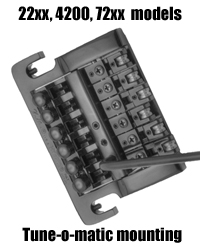
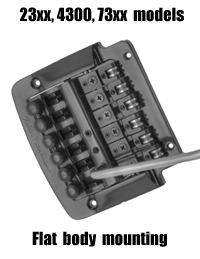
All tremolos crave routing. The flat mounting type is characterized by a flat square like chassis, which is screwed down flush against the body acme. The guitar fixed bridge is flat mounting and the guitar tremolos come in both flat and TOM mounting. The TOM bridge mounts onto the Tune-o-Matic style studs of the cease tail piece on hard tails.
As in mounting tremolo bridges, in that location are 2 fundamental words to remember when mounting a tremolo; alignment and alignment. The principles are the same for installing any span really. The intonation length must exist correct, usually 25 ½" from nut edge to bridge saddles. But there are several other scales both shorter and longer. The front to dorsum, side-to-side placement of the trem must also be correct. Once intonation and side-to-side alignments are made, and the trem mounted ...where do you want your bridge saddles be?" Food for thought....
These guidelines below are written for guitar retrofits and new construction, allow's get started...
Retrofitting:
If you are replacing your onetime trem or bridge with a new Kahler, you'll need to practice some grooming before removing your existing bridge assembly. Follow these next 5 steps before yous work on your new trem.If you are mounting a stud mount system and then see "mounting to a Les Paul" below.
1A) Place a strip of masking record on the surface of the guitar, beneath the strings, just in front of the bridge. 2A) Carefully make a centering mark on the record between the center two strings (that is, 3rd and fourth strings or "d" and "k" strings). Brand the mark with a brawl point pen by holding the pen perpendicular to the surface of the guitar scribbling dorsum and forth from string to string. Grip the pen close to the strings and keep it straight upwards for most accuracy. (see Fig 1 beneath).
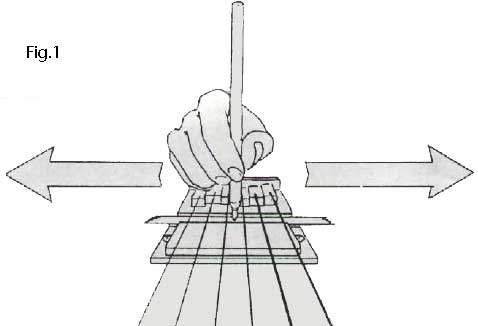
3A) Carefully remove the span from your guitar and retract the ground wire dorsum into the command crenel.
4A) Take the template #9537 and identify it nether the trem. Marker the mounting holes out with a pen using the trem as a guide. Punch out the marks with a sharp needle or pen and plough them into pocket-sized holes.
5A) Align the template on the surface of the guitar so that the centering marker you made on the masking tape, lines up in the center of the template.
FYI: The Kahler was originally designed around the Strat. Its nose fits perfectly into the pick guard cutout. The two are similar peas in a pod. The i drawback is that through the years with different models the runs are never exactly the same and therefore the slot route may extend out from underneath the body equally seen it the picture to the left. This happens near xx% of the time. The slot showing in the picture below is the worst case scenario. Helpful hint: You tin jockey the trem to the lower side and mount it while adjusting the saddles to the upper side to compensate. Mounting for Fender Stratocaster using a Kahler tremolo is a snap, only place the template in position using the ii outside of the existing drilled half-dozen holes. When mounted on a Strat, the strings at the rollers should be 9/16" off the body. Shim neck if necessary. Skip to #8A
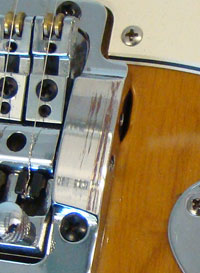
LES PAUL / Biconvex TOP MOUNTING...
Mounting any stud mountain system on a Gibson Les Paul or whatever arched top guitar with or without a one or two piece Tune-o-Matic type stop bar and span requires advanced woodworking skills.
Information technology is highly recommended that you become a professional Luthier to install the stud mountain systems, because the guitar is usually carved and not flat (like shooting fish in a barrel) to route
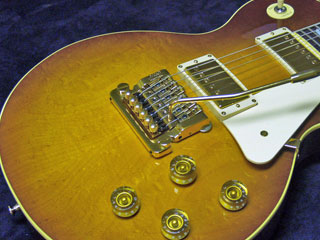
1A) To position the template #9536, measure from the nut to the 12th fret, and and then measure this same distance from the 12th fret down to the body, placing the leading edge of the template at this betoken. Then move the template forrad i/16". Mark out the routing cavity.
2A) We recommend a 3/eight" routing chip. Route down from the acme of the body ane" for the larger square of the template; route down ½" from the peak of the body for the smaller square of the template. You may place small wooden blocks on either side of the routing area for the router to rest on, then that the router will skim over the hardware and electronics, and they need not be removed. Proceed to road.
3A) Place front end riser inserts in the same position as the original TOM or i piece wraparound bridge mounting holes. Dowel and re drill to 5/16" if necessary. Gum tap in the bridge inserts. Next, Drill 1/ii" holes for studs. Gum and tap in the stud inserts. Mountain tremolo on guitar. Did y'all need a one/2" and 5/16" Imperial drill bit set for the stud mount system?
4A) If the bridge is non low plenty, take the risers wheels out and rest the unit on the torso meridian. If you demand to you tin raise the rear to achieve a shallower angle over the roller as recommended.
5A) To mount the string lock device, encounter lesser of page for fitting instructions.
New Construction:
Kahler tremolos are the easiest tremolo in the globe to install. Just follow these uncomplicated guidelines....
6A)T ake the template and place it under the trem.
7A) Adjacent, place the template on the body roughly where you recall the span will sit down. Do not attach information technology to the body all the same.
8A) With the smallest allen wrench (.050) included with your Kahler, loosen the cord spacing lock downs on the back of all the saddles. (run into below)
FYI: All Kahler CAM systems for guitars are in the same family, whether its a six, vii or 8 string, all share the same parts inside the frame. The same saddles, the aforementioned string hooks, fine tuners etc. etc. ALL are exactly the aforementioned. Simply the mounting plates (frames) are different. I model attaches to Melody-O-Matic (TOM) studs and the other gets screwed to the body with forest screws. Its the same with all the bass trem'southward and stock-still bass bridges also. The bass tremolo family unit share its parts within that firsthand bass family, even if the saddles are reversed they are notwithstanding the same saddles that are on frontward roller versions. Same goes for the iv,5,6,7 and eight cord fixed bass bridges. Frames are dissimilar only the parts are the same.
9A) Move the loftier and low Due east saddles to the extreme outside edges and re tighten these two just. Now you can really see the maximum string spacing a Kahler has to offering and can better align the trem upward with the neck.
10A) Slightly loosen the phillips on top of the middle of each saddle. Now pull out each saddle fork about 5/16" or 2/third of the fashion out and line them up every bit, secure them by lightly re-tightening the Phillips screws (right)
11A) Now take the saddle height risers and, lower the saddles to about 9:fifteen o'clock or .500 (ane/2" - 12.70mm). This is the best scenario for staying in tune perfectly. The higher you lot brand the rollers, the sharper the cord curve is over the roller, and thus more than downward pressure on the roller pin is created which means more drag. Drag is a tremolos #ane enemy. Retrieve this, and you will be fine. Next... raise or recess the trem if necessary to keep this depression roller pinnacle and saddle angle. The Kahler works best and has the good resonance and tone at this lower range of saddle acme because the cord even so has proper force per unit area on the roller. If you get any lower, it should be for calculation a radius to your strings. Please note: You can go college with the saddles and not hurt tone or resonance, but keep in mind that more drag will be noticed. You ultimately will want to notice that happy identify where the activity/ saddle height is nice and low, but notwithstanding plenty downwards cord pressure is kept on the roller to keep solid contact with the strings. Its almost all-time to adjust the guitar to the tremolo when its configured as recommended.You are now prepare for alignment measurements.
12A) Starting time lets get the front to dorsum (north / s) placement down ....(see and read the illustration below)

Now we need to go the side to side (east / west) alignment with the neck figured out....
13A) To do this, take the two unbent outside strings from your cord pack and drop the ball end into their corresponding string hooks, and so string them through the nut and/or lock and finally slip them through the tuners. At present turn the tuners some, just plenty so the tuner grabs the strings, but yet y'all can even so pull the strings through the tuner hole to keep the tension on them. Basically your trying to line up the strings properly downward the center of the cervix using the 2 exterior saddles with strings, as a fret board edge reference. At that place no need to wind the strings allot on the tuners for this exercise.
14A) With strings lightly taught, movement the Kahler from side to side until the string lies equally from either side of the fingerboard then middle the trem rollers that are in line and 2/3rds of the manner out, right over the intonation line you marked out before. Mark the spot. So betwixt the intonation line which places the trem in the correct north/south placement, and where the east/west placement ends up, is where the trem gets mounted. "X marks the spot". With a long tipped felt pen, and existence careful non to move the trem, brand a dot for the 2 front end mounting holes by sticking the tip of the pen through the 2 front mount holes and mark the body. Endeavor to keep the pen directly up as possible when marking the spots. Remove the trem off the body at present, de-cord and set bated.
15A) Lay the two front screw holes of the template over the two front marks y'all merely fabricated on the body. At his point if the template seems off kilter a tad, just straighten it out... simply no more than that. At present tape down the template on all four sides. Mark the rear holes out. Using a 3/32" drill bit, drill pilot holes 1" deep for all iv Kahler bridge screws, according to the template.
16A) Carefully scribe the guitar surface along the inside perimeters of the template with a abrupt object. (NOTE: a clean, sharp line here will prevent the pigment from chipping during the routing of the cavity)
17A) Mask off the residuum of the body expanse to protect it from the router, and road out the cavity to a depth of one inch. Road area with 3/8" diameter (or smaller) scrap, 1" deep. If needed, or for new construction, drill a string footing hole between the Kahler cavity and the command cavity. Run ground wire into i of front end screw holes.
18A) Screw the tremolo or bridge into identify with mounting screws supplied. Mounting an "after the nut" Cord lock...
1B) Identify the Kahler string lock on the head stock behind the nut. To work at its best, the Kahler string lock must be positioned as close every bit possible to the original nut, merely be at plenty of an angle below the nut so the strings are pulled down snugly into the nut slots. It must also be as close as possible to the original nut to minimize string slack when the string tension is reduced via the arm. The original nut will now serve primarily as a string guide for the cord lock. Align the string lock. behind the original nut so that each of the three clamps is fairly well centered with the E and A, D and G, and B and Eastward pairs of cord slots. Sight through the string slots and move the string lock. until the top sides of the clamps autumn just beneath your line of vision. Using the cord lock. as a guide, drill 4 pilot holes using a 5/64" bit. Screw down the nut using the provided screws and a tiny phillips screwdriver to foreclose damage to the heads of the screws. The procedures for installing the Pro string lock. are pretty much the same. To drill the pilot holes you volition take to remove the finger-locking clamps. Just unscrew the retaining rod and pull information technology out. The clamps will autumn off. Drill the holes and mount the chassis on the head stock and reassemble. The Pro cord lock. requires just finger tightening of the screws and then snapping of the clamps to lock information technology. No wrenches are used.
2B) Sure neck styles will most probable crave a shim or spacer under the cord lock to provide the right string angle from the nut to string lock and ensuring correct operation. Overall best cord lock position is equally shut to the nut equally possible and with a slight string angle from nut down to string lock.On guitars with a truss rod cover such every bit a picture/LP bell cover (below), mount string lock directly on head stock and trim off terminate of truss rod bell cover to butt up to cord lock.
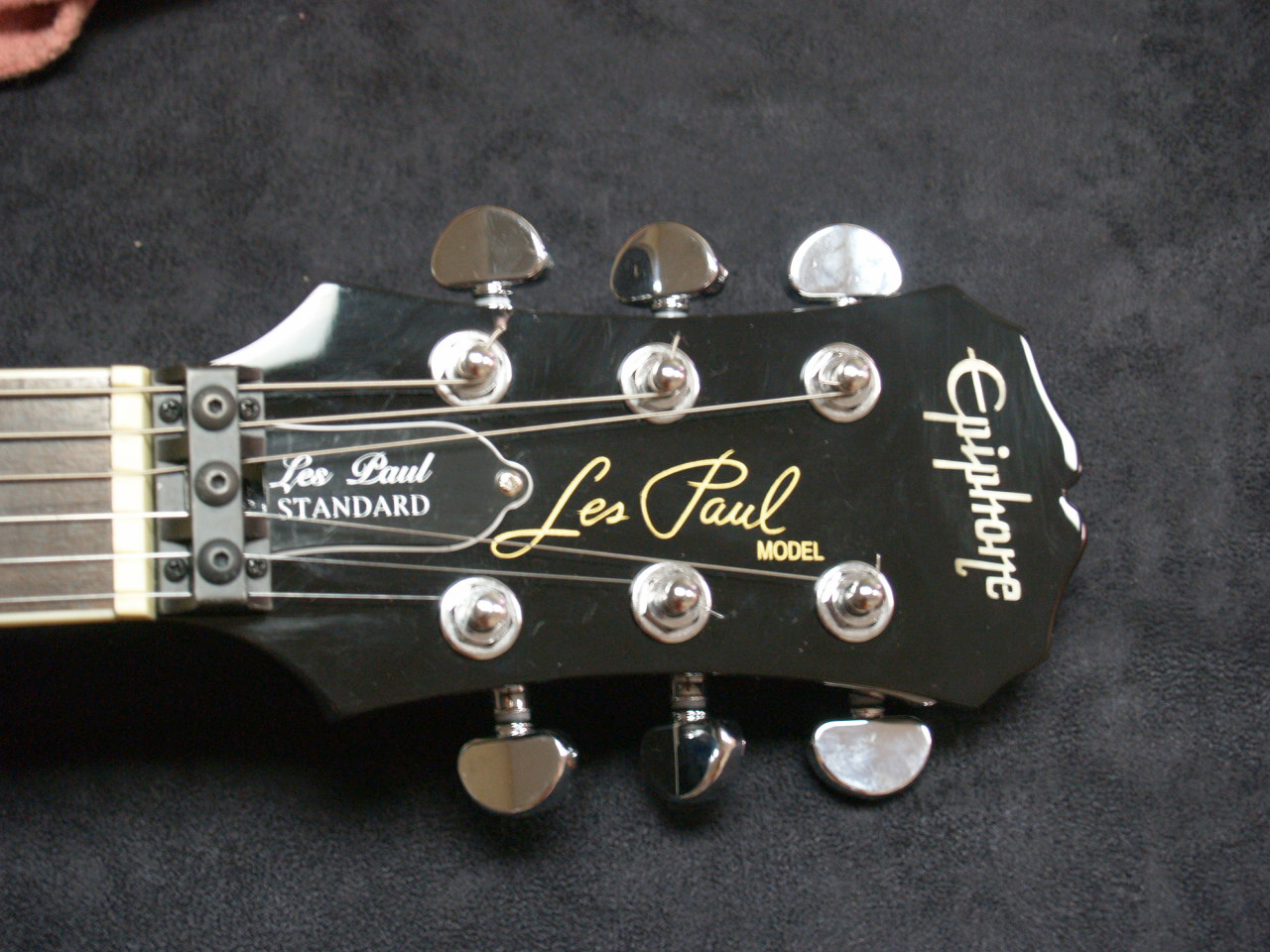
3B) String up your guitar.
Set adjustments...
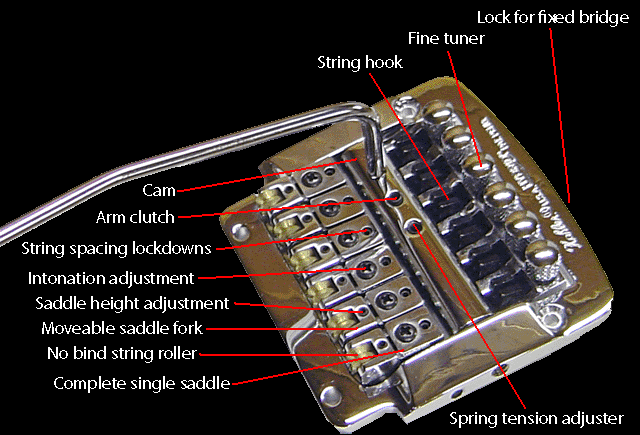
Learn what a versatile tremolo is all nigh. Exercise you know what these adjusters do? From summit to bottom...
i) Lock for fixed bridge. Turn this Allen screw to lock the tremolo and go from gratis floating to stock-still span.
2) Fine tuners for fine tuning adjustments after your strings are locked down at the neck.
3) Top loading cord hooks with a .60 slot for strings upwards to size .46 (.90 slots for strings .48 - .60 are available)
4) The CAM . This is where the depth of your tone comes from! The arm screws into it and you push down or pull up on the arm to actuate the CAM motion.
5) Arm clutch is used to control the arm swing. The arm stays where you exit it when its engaged. It's fully adaptable from "stay where you left information technology" to "let 'er swing till supper".
6) String spacing lock downs lock your saddle where yous want it for desired string spacing.
seven) Intonation adjustment. This unloosens the fork so you tin can slide it in and out for proper intonation.
8) Saddle height adjustment. Raises and lowers the saddle for adjusting the radius and activity.
9) Saddle fork. Pull it out...push it in. Intonate.
10) String roller for stationary intonation during pull backs and dive bombs. You can actually do lead solos while dive bombing and stay intonated the whole time! The string roller provides the salt and pepper to the main CAM s tone. Steel gives some crispness clarity while Teflon gives your tone sustain with girth and of class the brass makes things warm and inviting.
11) The consummate unmarried saddle has viii parts to it. Working from the bottom, up... The heart clamp (you cant encounter it in the picture) is slid onto the saddle rod. The fork is placed on top of the eye clench and then some other clamp plate sits on top of it all. A screw holds all three pieces together. A small allen sits over the rod at the cease of each saddle. Information technology locks the saddle to the rod once you make up one's mind how you desire your string spacing. On the front end side, The fork has a contumely or steel roller on the finish of information technology with a pin going through its axis. Just behind the roller, on the fork, at that place is a small allen adjuster which is used to raise or lower the saddle to achieve your desired radius and action. The fork slides in and out of the fork for intonation. in one case intonated the phillips is used to clamp the plates while sandwiching the fork and holding it all in place.
12) Bound tension adjuster. The virtually misunderstood yet versatile adjustment on any tremolo. Technically known as a "load level adjuster", information technology'due south many uses include:
#one Apply it to loosen or stiffen the feel of the arm for versatility.
#2 Use it to raise and lower the arm for playing comfort.
#3 Utilise it to compensate for heavier strings gauges and diverse drop tunings.
#4 Use it to level the CAM out for optimum palm muting.
#5 Use it to adjust the CAM locking pin alignment so you can lock and unlock fast, during the set.
#6 Use it to globally up melody or detune the strings to recoup for warm or cold weather.
String selection...
1A) Cord choice is a highly personal matter but with a tremolo arrangement yous are relegated to using TREMOLO REINFORCED strings. GHS Boomers, Roto Sound, and Sit Power Wound strings are a superior pick and never fail a Kahler. Using Ernie Brawl strings on a Kahler is not recommended. EB's are good strings but they don't hold tune well on the Kahler CAM systems because of the G string winding and ball end. .009-.042'south or .010-.046's have always been the recommended choice for a Kahler CAM system. If you use heavier strings, you will demand the heavy tension springs and wider string hook #9408 to compensate. The string claw opening is only .060 on all 6 string models, for the 7th and 8th strings on seven and 8 string models, wider slots are included. The wider slotted string hooks Function #9408 are bachelor for your 6 string trem if your into those bass sized strings.They are good for upward to .090 at the windings ( or most a .070 string) so must as well take into consideration the doubled over size of the winding at the brawl cease. Its always well-nigh an extra 1/2 of what the cord bore is. You always want a little play in the hook. One matter that you MUST Practice is put a soft 45 degree bend in the windings of the ball finish (beneath). This prevents the ball from spinning in the hook and reseating wrong. String hooks tin intermission if all the rules are not followed...Curve the string every bit shown and do not used oversized windings.

Proper Intonation...
There is a science to the way kahler saddles human activity that is IMPERATIVE you understand for mounting and intonation purposes. The fact that the Kahler saddle pivots upwardly and down and is held in place from only one end of the saddle ways that there is an arc in the travel of the roller. See the flick? The saddles are at the farthermost height in this example which by the way is the worse place for the saddle acme to exist because the cord pressure binds the roller upwardly. To go along... what happens when you driblet the saddles flat? The roller comes down with the saddle Just if y'all discover, the roller is also traveling in a forward arc, equally y'all bring the saddle downwardly....and visa versa. When yous raise the saddle, the roller goes up and back in an arc. If you were adjusting the radius, at this point you would have to pull or button the fork in or out a little to keep the roller over the intonation signal. This must be kept in mind as you figure out where your saddles volition end up afterwards you intonate them.
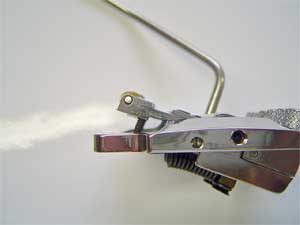
The reason you start out with the forks and risers two/3rds out, is that y'all need some room to retract them, or simply put... motility the saddles back during intonation.
If yous've noticed the loftier e string saddle sticks out furthest in all setups and the the rest of the saddles are retracted until the low Due east is retracted the well-nigh then if you lot had the saddles all retracted inwards, and so y'all would non be able to movement them inward whatsoever further when needed. See staggered saddles pictured beneath. Imagine the fork is sliding back and forth in in a dramatization, do this while keeping the roller at the aforementioned meridian. Information technology's impossible. The saddle will pivot in an arc even higher, because of the non moving "stilt" (saddle riser) underneath. In social club for this to happen correctly and keep the aforementioned saddle height, you need the saddle riser to compensate past screwing dorsum within the saddle as the fork is going in. The farther dorsum the fork gets pushed , the saddle riser needs to be screwed in farther and visa versa...get information technology? Both work in concert together.

To recap: Decide the mounting situation and your desired action kickoff, then with the trem mounted in this pre-configuration style, you'll have plenty of room to intonate and radius the strings afterwards on.
Recollect: Reversed saddled bass trem's are simply the opposite.
Proper intonation will assure that your guitar plays perfectly up and down the fret lath and plays in perfect melody at each fret, at least as perfect as possible since perfect intonation is physically incommunicable. Setting the intonation on your bridge is easy, especially if you lot have a Kahler CAM system. All you have to do is know a few rules of the road. The simplest examination for correct intonation is to strike the harmonic at the twelfth fret then play the 12th fret. Past comparing the notes, you lot tin make up one's mind if your intonation is out of whack or if it'south right on the money. But the homo ear is not perfect. You really need a visual reference.... yous need an electronic tuner or to get even a more than precise intonation experience, y'all need a strobe tuner. But strobes are expensive and shelling out several hundred bucks to intonate a few guitars is not necessary unless you're getting into the biz. A expert quality electronic tuner with a needle volition do just fine. So to start….
1D) Switch to the neck pickup and max out the volume.
second) Tune your guitar to standard 440 tuning using an electronic guitar tuner.
3D) Once tuned up, lightly touch your finger on the small E string right over the twelfth fret and strike it for a harmonic sound. The tuner should read dead on zero considering you just tuned it correct?
4D) Next, actually play the 12th fret. Don't button hard. You lot don't desire to stretch the string over the fret giving you a false reading. Watch the tuning line. If the needle goes to the right of zero, the string is sharp…y'all need it longer. Left of zero means its flat…you desire to shorten the string. Note: If the needle is erratic, lower the cervix pickup volume and or the cervix pickup a bit. You're now prepare to motion on to the next step... FYI: On all Kahler CAM systems, each saddle has a fork with a roller, the fork slides back and forth through the clamp plates. Barely loosen the Phillips just enough while keeping some clamp plate tension/grip then information technology won't exist necessary to re-tighten betwixt re-tunings and re-tests.
5D) If the string is abrupt, or to the correct of the marking, it needs to be made longer. Barely loosen the Phillips in the saddle clamp plate and push the saddle back a tiny footling bit, effectively lengthening the cord. If the needle shows to the left of the zero mark, the string is flat and the string length needs to be shortened. Move the saddle fork a little toward the pickups.The thought here is to get the both open and fretted notes to be exactly the same on all vi strings. They should match exactly at zero.
6D) Once all the strings are intonated, tighten the Phillips and double check each cord for intonation. Redo them if necessary.
Maintenance of your Kahler CAM system...
For all series of Kahler tremolos and fixed bridges with string rollers. Go along the unit clean from dirt and droppings at all times. String rollers are a big cause of out of tuning bug. They must be kept make clean and free of hand gunk. The rollers must be kept low and never lube and they should whiz for a full second when y'all quickly spin them with your finger. Always keep thing clean and dry out. More chiefly you must change the springs every three-five years equally recommended or else tuning bug ascend. Stringlock'southward should exist checked for grooving, otherwise Kahlers are congenital like tanks and when setup correctly will last a long time giving you years of maximum enjoyment and superlative notch performance. Go ahead, it ok, be a rock star!
Troubleshooting the Kahler Tremolo Systems after an install...
When installed properly, the Kahlers piece of work quite well. But installation oversights tin can cause these systems not to perform upward to par. If the tuning isn't returning to correct pitch afterwards dive bombing, check the feel of the arm for smoothness. Does it feel like the organization is dragging or catching on something every bit it moves? Check the tremolo cavity for obstructions. The CAM should not touch whatsoever wood when at rest. This will foreclose the system from returning to pitch. On the Kahlers with rollers, the angle of the cord across the rollers should be shallow. If besides shallow of an angle information technology will cause cord rattle. All guitar players are later the everyman action possible. Its our quest in life, side by side to tone... correct? But players tend to driblet the saddles too low in an effort to become that perfect activity. This is not a skilful matter for sustain and tone. That'southward why yous setup your guitar around the tremolo. On the other cease of the guitar, the cord lock. or locknut should be anchored deeply. Driblet the cord tension with the arm and notice the string lock. or locknut. When you bring the strings back up to pitch, does the nut appear to motility? If it rocks during this procedure, information technology needs to be tightened. Pull dorsum severely... If the strings return flat, you may just need to clamp the strings tighter.
Troubleshooting tuning after the pause in catamenia...
Tuning problems usually are caused by several reasons, they are:
1) The Normal Tension Return Springs PN# 8412 are fatigued and worn out. Replace them. If you desire y'all can upgrade to a Heavy Tension Springs PN# 8413 for a firmer feel similar to a Floyd Rose. Also you desire to check to make sure the Spring Mounting Screws PN# 8392 are snug and tight. If they slip it won't return to eye.
2) If your tremolo does not return to center, then you might desire to inspect the locking device on the neck to encounter if one or more strings are slipping through the clamp plate. The strings somewhen create a worn out aqueduct dug out of the clamp plate. If this happens it volition change the tension over the entire CAM and it wont eye out correctly. Audit them and supersede if necessary.
3) Is the string lock screwed tightly to the caput stock? If it is non, information technology may shift occasionally causing general tuning problems. Effort testing it by placing your thumb and index finger on the sides of the cord lock extending down onto the cervix or head stock. Push the vibrato bar downwardly every bit far every bit possible then pull it upwards every bit far as possible. If the string lock is moving or shifting positions, you may be able to experience slight vibration or movement. Sometimes you tin can even hear a faint "click" or "chink". double cheque and tighten all mounting screws firmly.For deluxe string locks to part properly, tighten the screws simply "finger tight" and then back off ane/iv turn. Snap close the levers. If they do not close with slightly firm snaps, open the levers and tighten or loosen the screws slightly as needed. Repeat until the levers snap close with a gentle push. Do not use tools to strength the levers closed.
4) Are the saddle rollers rolling? If the rollers or a roller does not curlicue easily, the tuning of the unit can be greatly impaired because the roller volition create drag on the string resulting in tuning mistake for that string or cause the entire unit non to remainder accurately (resulting in general out of tune result). To examination this, remove a string to the side of the roller and rotate the roller with your finger. Replace the string onto the roller and move the tremolo arm up and down. Does the roller appear to roll? Solution: If a roller is stuck, you demand to remove the pin and clean the roller and pin with some WD40 then rinse them with booze to eliminate whatsoever oil residue. Encounter changing the string rollers video. Supersede the rollers and keep clean and dry. Are the rollers too high? If the rollers are very high, they may be causing friction which is keeping the CAM from balancing properly. When a roller is very loftier there is more pressure from the string exerted on the roller and therefore more friction between the roller and its beam pivot. This friction is often the cause of general tuning problems and is very oft the cause of the specific tuning problem which is that the strings tend to stay flat when the arm is pushed down and released and the strings tend to sharp when the arm is pulled up and released. High rollers are also often the cause of string breakage because of the increased angle of bend in the string and greater contact pressure. This breakage will occur at the roller. Visually look at the rollers from the side of the guitar. Exercise they appear to be set high? The optimum roller height for tuning stability is almost ix:15 o'clock.
5) Are the springs free from obstacle when the tremolo is in all positions? If the springs ever hit anything they can make audible noises and fifty-fifty cause turning problems. Solution: Deepen or widen the spring cavity to provide clearance.
Source: https://www.whammyparts.com/faq/149-kahler-guitar-tremolo-installation-guidelines
Posted by: wrightwerighly.blogspot.com


0 Response to "How To Install Tremolo Bridge"
Post a Comment